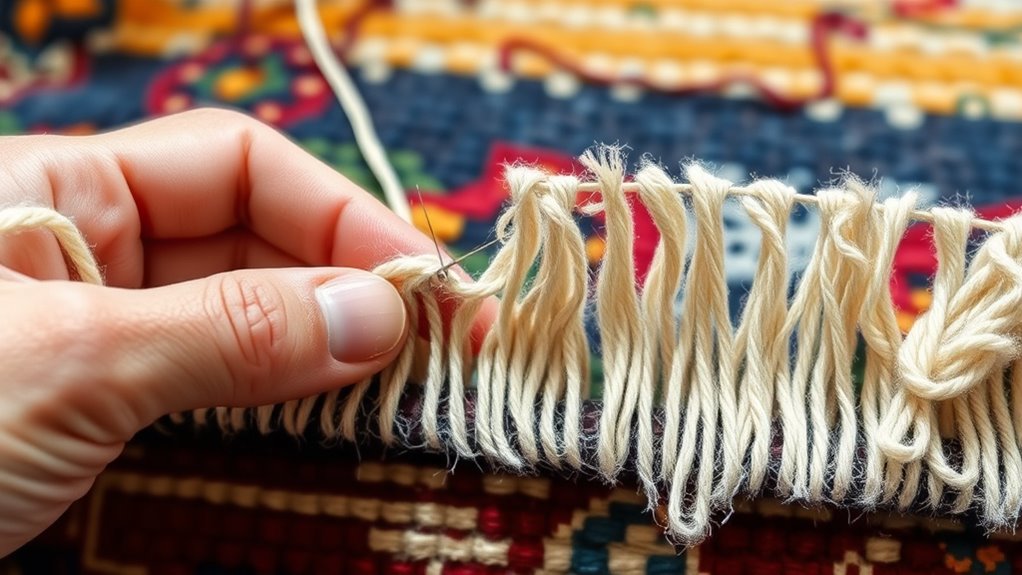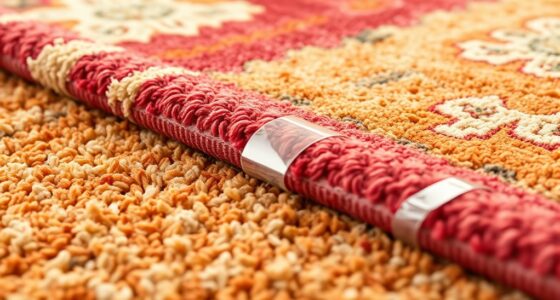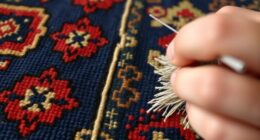To repair your rug fringe at home, start by inspecting the damage and gathering supplies like matching thread, needles, scissors, and replacement fringe if needed. For frayed strands, trim and reinforce or reattach loose fibers with strong adhesive or stitched attachments that blend seamlessly. Replacing missing fringe involves attaching new strands carefully, ensuring they match in color and texture. With regular maintenance such as brushing and gentle cleaning, you can keep your fringe looking its best—keep going to explore simple tips for perfect results.
Key Takeaways
- Identify the fringe material and style to choose appropriate repair methods and materials.
- Secure frayed or loose strands with matching thread and small, neat stitches for a seamless fix.
- Trim minor frays with scissors and reattach loose fringe using textile glue or needle and thread.
- Replace missing fringe strands by dyeing new threads to match existing fibers and attaching evenly.
- Maintain fringe health by regularly untangling, brushing gently, and avoiding aggressive vacuuming.
Assessing the Damage and Gathering Supplies
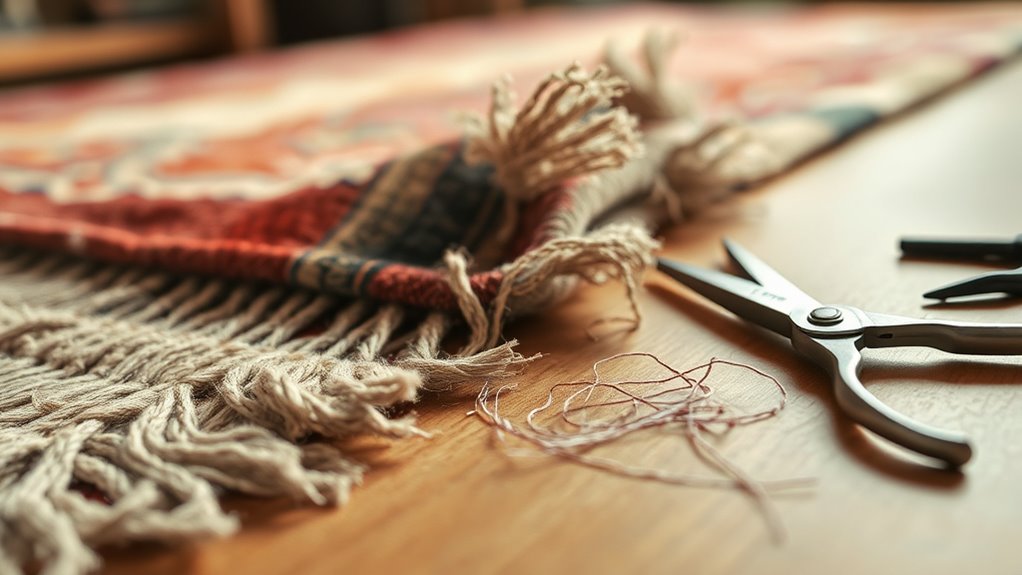
Before you begin repairing your rug fringe, it’s important to assess the damage carefully and gather all necessary supplies. Start by identifying the fringe material, whether it’s cotton, wool, silk, or synthetic fibers, as this influences your repair choices. Take note of the rug’s fringe style—whether it’s twisted, knotted, or layered—so your fix matches the original look. Inspect the damage for frayed, torn, or missing strands, and determine whether the entire fringe needs replacing or just minor touch-ups. Once you understand the extent of the damage, gather supplies such as matching thread, needles, scissors, and replacement fringe material if needed. Proper preparation ensures your repair is effective and blends seamlessly with the existing fringe. Additionally, understanding the fringe material can help you choose the most suitable repair method to ensure durability and a cohesive appearance.
Repairing Frayed or Torn Fringe Strands
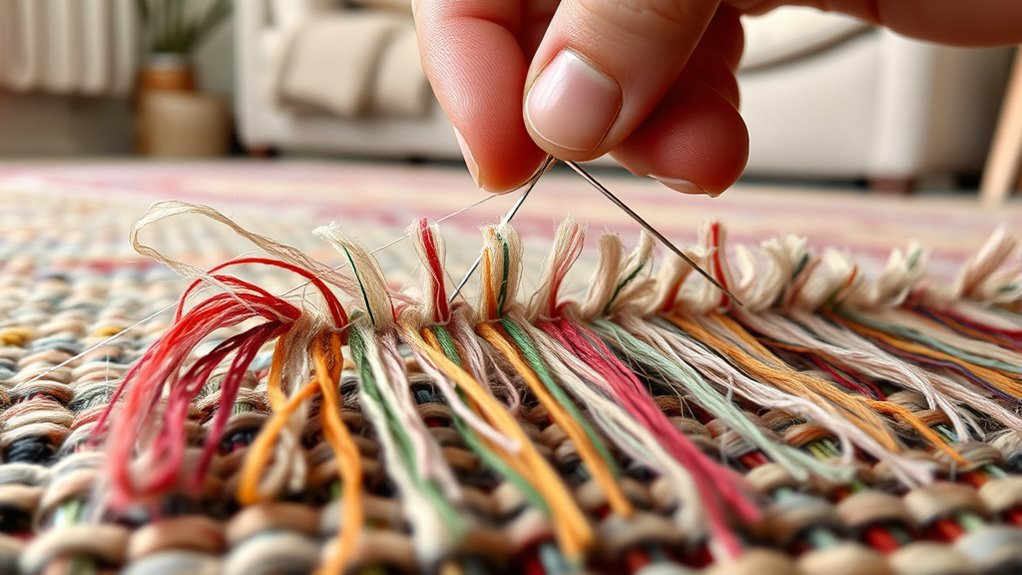
When repairing frayed or torn fringe strands, start by securing the area to prevent further damage. Carefully examine the damaged fringe to determine if you need to replace or reinforce the strands. If replacing, choose a fringe material that matches your rug’s original style and texture; this guarantees a seamless look. For minor frays, trim the damaged fibers neatly with scissors. If the fringe has torn further, consider reattaching loose strands using a strong, clear adhesive designed for textile repair. To maintain color consistency, use dye matching if you need to color or touch up the fringe. Test any dye on a hidden section first, ensuring it blends with the existing fringe. Proper fringe material selection and dye matching help restore your rug’s appearance while maintaining its integrity. Additionally, understanding fiber types can guide you in selecting the most suitable repair methods and materials for your specific rug, especially when considering Kia Tuning options that improve performance and aesthetic appeal. Knowing the best shampoos for highlighted hair can also help if your rug’s fibers require gentle cleaning to avoid damage during the repair process. Being aware of personality traits can help you stay patient and precise during delicate repairs, ensuring a professional finish.
Reattaching Loose Fringe to the Rug Edge
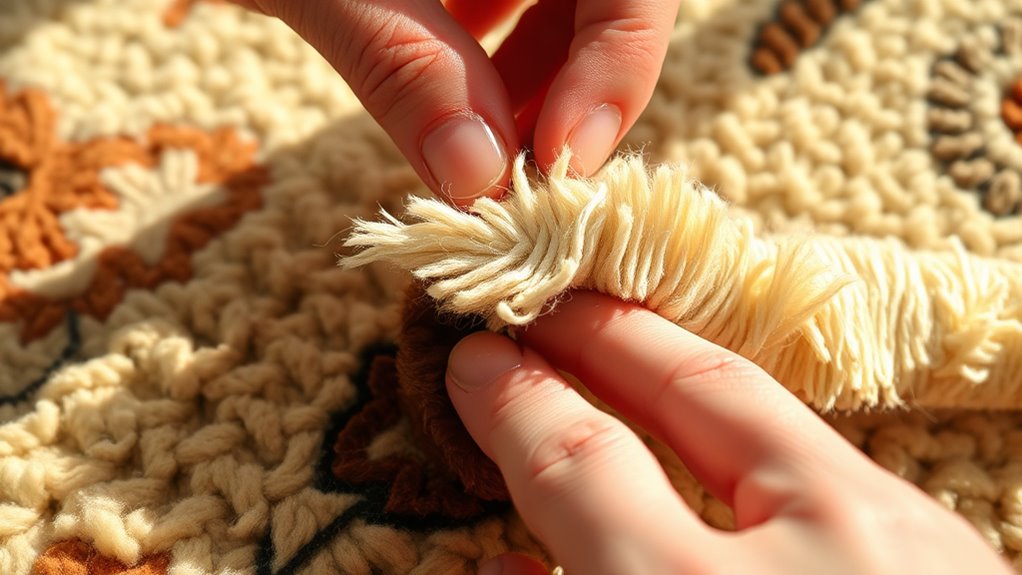
Noticing loose fringe can be frustrating, but reattaching it is straightforward with the right approach. First, choose a fringe material that closely matches your rug’s existing fringe in texture and color. When selecting fringe material, consider the original fibers and opt for a similar type for a seamless look. To reattach, thread a needle with strong, matching thread, and secure the loose fringe to the rug’s edge using small, neat stitches. Pay attention to dye color matching; if your fringe is faded or discolored, you might need to dye new fringe strands to match the original. Carefully blend the new fringe with the existing strands for a uniform appearance. Additionally, understanding rug construction and materials can help you make better choices for repairs and maintenance. Being aware of the types of rug fibers used can also guide your selection of appropriate repair techniques. Incorporating advanced repair techniques can further improve the durability and appearance of your rug’s fringe. With patience and precision, you’ll restore your rug’s fringe, enhancing its overall look.
Replacing Missing Fringes With New Threads
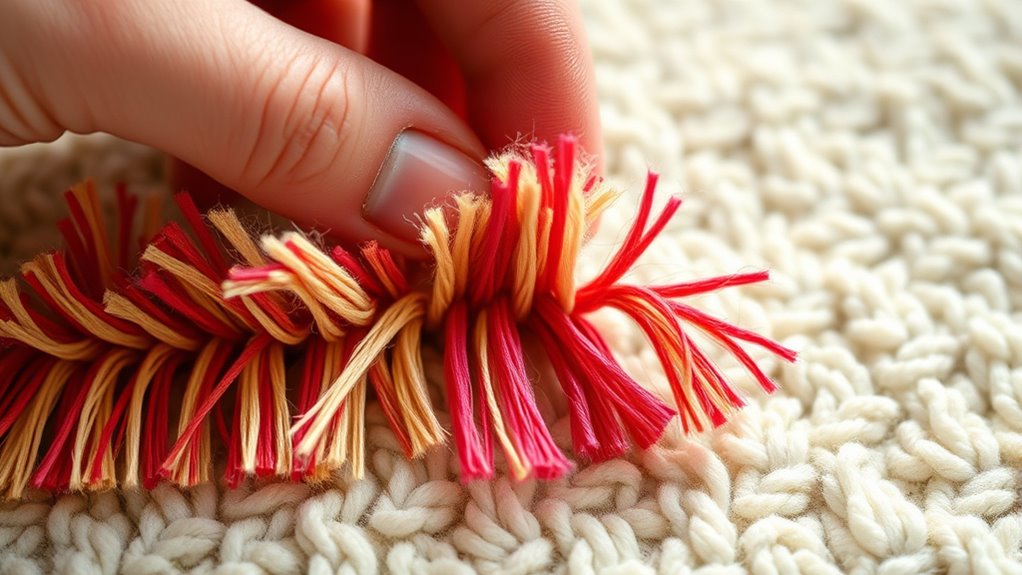
Replacing missing fringes with new threads involves carefully selecting materials that match the original rug’s fibers and color. Start by choosing threads similar in texture and hue, or consider fringe dyeing to achieve an exact match. If the original fringes included decorative trims, replicate these details with matching or complementary trims for a cohesive look. Use a needle and strong thread to securely attach the new fringe to the rug’s edge, ensuring it’s evenly spaced. Fringe dyeing can help blend the new threads seamlessly into the existing fringe, especially if you can’t find an exact match. Take your time to align the threads properly, and double-check that the new fringe feels secure. Proper wall organization techniques can make the repair process easier by providing a clean workspace and keeping your tools organized. Ensuring proper maintenance practices can also prolong the lifespan of your rug’s fringe. With patience, your rug will regain its full, decorative appearance.
Preventative Tips to Keep Your Rug Fringe Looking Its Best
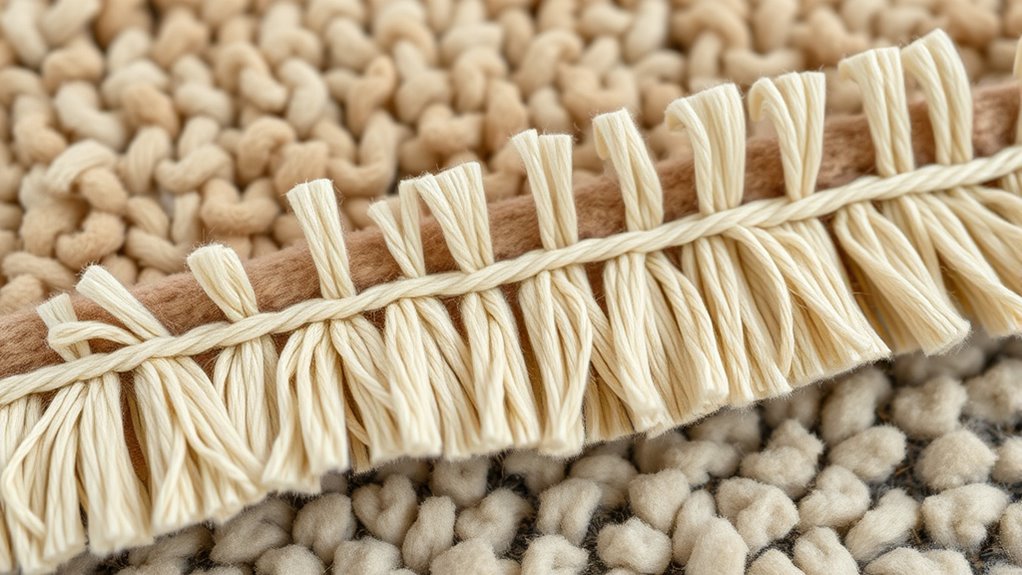
To keep your rug fringe looking its best, regular maintenance and mindful habits are essential. Properly caring for the fringe design prevents damage and extends its beauty. Avoid pulling or tugging, which can cause fraying. Instead, gently straighten and untangle knots during routine rug maintenance. Use a soft brush to keep fringes free of dust and debris. When vacuuming, set the machine to a gentle setting and avoid the fringes to prevent unnecessary wear. Consider rotating your rug periodically to distribute foot traffic evenly. Maintaining color accuracy in your cleaning tools can also help preserve the vibrant appearance of your fringes. Additionally, understanding sound vibrations and how they influence cellular regeneration can inspire more mindful cleaning practices that protect delicate fibers. Being aware of vibration effects can help you choose less invasive cleaning methods. Below is a simple guide to help you stay on track:
| Tip | Action | Benefit |
|---|---|---|
| Gentle Cleaning | Use soft brush and mild cleaners | Preserves fringe integrity |
| Avoid Pulling | Handle fringes delicately | Prevents fraying |
| Regular Rotation | Turn rug every few months | Even wear and longevity |
| Mindful Vacuuming | Use gentle settings, skip fringes | Reduces damage |
Frequently Asked Questions
How Often Should I Inspect My Rug Fringe for Damage?
You should inspect your rug fringe regularly to catch damage early. For effective fringe material maintenance, aim for inspection scheduling at least once a month, especially in high-traffic areas. Check for fraying, loose threads, or unraveling. Regular inspections help you identify issues before they worsen, making repairs easier. By staying proactive with your fringe inspection schedule, you keep your rug looking fresh and extend its overall lifespan.
Can I Repair Rug Fringe Without Sewing Skills?
You can definitely repair your rug fringe without sewing skills by following simple DIY tips for fringe preservation. Use clear glue or fabric adhesive to secure loose ends, and consider knotting frayed strands carefully. These techniques help maintain your rug’s appearance and prevent further damage. With patience and some basic tools, you can effectively restore your rug’s fringe at home, saving money and preserving its beauty for years to come.
What Tools Are Best for Delicate Fringe Repairs?
For delicate fringe repairs, you’ll want to use the best tools for fringe reinforcement and delicate fiber tools. These include fine-tipped tweezers to handle fragile fibers carefully, and small, precise scissors for trimming. You might also consider using a light adhesive designed for delicate textiles to secure loose fibers. Avoid bulky tools, and work slowly to prevent further damage, ensuring your fringe stays intact and looking neat.
Will Repairing Fringe Affect the Rug’s Value or Appearance?
You might think repairing fringe affects your rug’s value or appearance, but if you match the fringe color and material carefully, it often looks seamless. Properly done, your repair won’t detract from the rug’s charm—sometimes it even adds character. Ensuring fringe color matching and material compatibility keeps the repair discreet, so your rug retains its beauty and value. When done correctly, your repair should blend in naturally.
Are There Professional Repair Services Recommended for Extensive Damage?
If your rug has extensive damage, you should consider professional restoration services. Experts can properly repair or replace the fringe, guaranteeing the rug maintains its value and appearance. They often provide a rug appraisal before starting work, giving you a clear idea of costs and quality. Relying on professionals ensures your rug is handled with care, especially for valuable or antique pieces, preserving its beauty and worth long-term.
Conclusion
With these simple at-home techniques, you can effectively repair and maintain your rug’s fringe, saving money and extending its lifespan. Did you know that properly cared-for fringes can last up to 20 years longer? Regular inspections and quick fixes prevent further damage, keeping your rug looking fresh and stylish. So, take a little time to care for your fringe—you’ll enjoy a beautiful, well-maintained rug for years to come.
